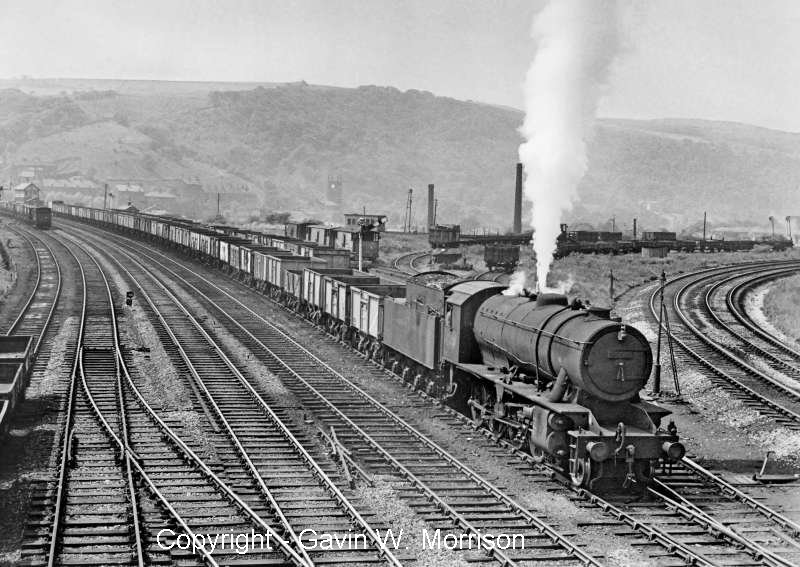
Hall Royd Junction: the prototype - 2
Past and Present
In the mid-1950s Ben Brooksbank took a photo of the railway looking north from Hall Royd Road bridge. It showed a scene of great industry, with a steam-hauled long empty coal train heading back to the Yorkshire pits; a newly outshopped BR Standard Class 4 pottering about in the sidings and a banker ready in the background for the next Copy Pit-bound freight train. That was nearly 60 years ago, and the following shots show the remarkable decline and fall of this once bustling centre, and then David Greenfield's photo shows the remarkable renaissance that is taking place. Caldervale has - for now - been knocked of a list of lines for inclusion in the next round of electrification, so who knows what the next 60 years may hold for Hall Royd?
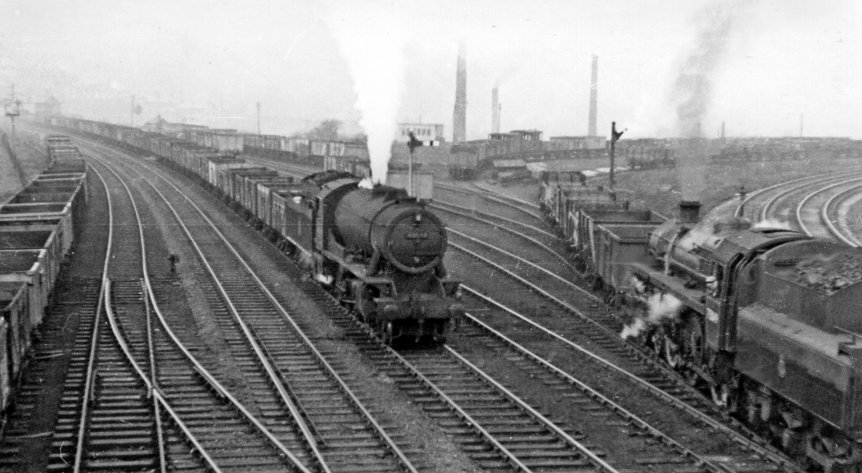
A coal train for Lancashire approaches from the direction of Sowerby Bridge, Wakefield etc., headed by ex-WD 2-8-0 No. 90548, which was built as WD No. 7079 (later 77079) in 9/43, loaned to the LNER until shipped to France in 12/44, returned in 6/46, stored at Kingham until loaned to the GWR at Oxley in 4/47, transferred to BR(LMR) at Newton Heath in 3/50 and eventually withdrawn in 5/64. On the right is BR Standard 4MT 4-6-0 No. 75049 (built 11/53, withdrawn 10/66).
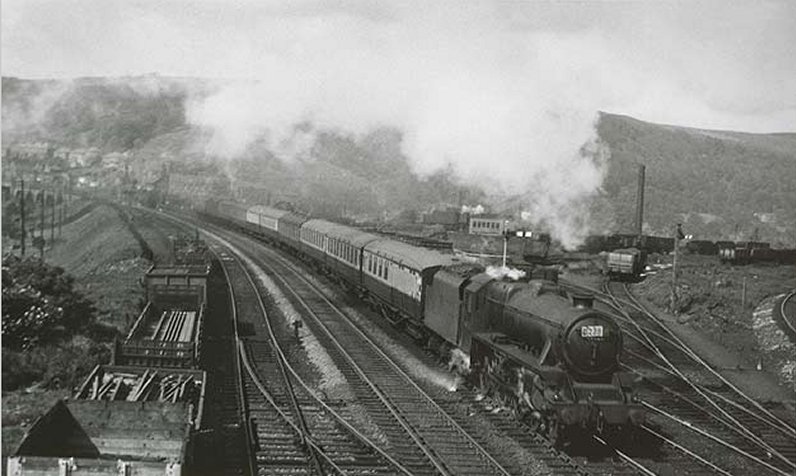
Reproduced with by kind permission of the Roger Birch collection.
Black 5 approaches Hall Royd Road bridge with a train of Gresley carriages in the early 1950s red and cream livery. The fourth and sixth carriages might be the then new BR Mark 1s. There is a Stanier 8F standing on the Banker siding in the background.
Copyright Gavin W Morrison
Gavin Morrison has kindly allowed reproduction of two photos showing atypical sequence of events at the Hall Royd Junction Down loop and sidings. In the first view (above) Riddles 'WD' class 2-8-0 No. 90523 has entered the Down loop at Todmorden East signal box with an eastbound train of empty coal wagons on 14 June 1961. The train has 41 wagons or thereabouts: the maximum load was 55. The train is about to cross the points that serviced the goods and Permanent Way sidings located here. These points were protected by Hall Royd's signal 6, which is 'off' in the photo. On the left had side of the photo can be seen the Up loop, and a freight can be seen moving out of it onto the main line. In the siding on the extreme left can be seen a short raft of low-sided permanent way wagons. In the last couple of years before this siding was lifted c. 1966, it was home to two LMS Period II carriages.

In the second view the WD has stopped, the rear of the train uncoupled, and then the front of the train has been pulled forward so that it can be set back into the Hall Royd sidings. Whilst this is going on, ex-LMS Stanier 'Black 5' class 4-6-0 No. 44928 passes on the Down main an express working for Leeds on 14 June 1961. To the left of the last coach of the express can be seen a surviving LYR bracket signal. This has lost its finial, and also it would appear that the small shunting arm that controlled exit from the siding has been removed, and replaced by a ground signal at the foot of the post. This will shortly be replaced by a steel bracket and upper quadrant arm. Note the Midland 4F on a local trip working in the back ground, heading for Stansfield Hall Junction. It is passing the banker sidings, which are currently unoccupied.

Photo G Roose, Copyright J. K. Wallace
A three-car Class 101 DMU at Hall Royd Road bridge heading for Leeds on 2 April 1979. Graham notes the train as 7V37.

Photo G. Roose, Copyright J. K. Wallace
Three-car Metro-Cammell Class 111 DMU in all-blue BR livery approaches Hall Royd Road bridge with train 7Y39 on 5 October 1979.
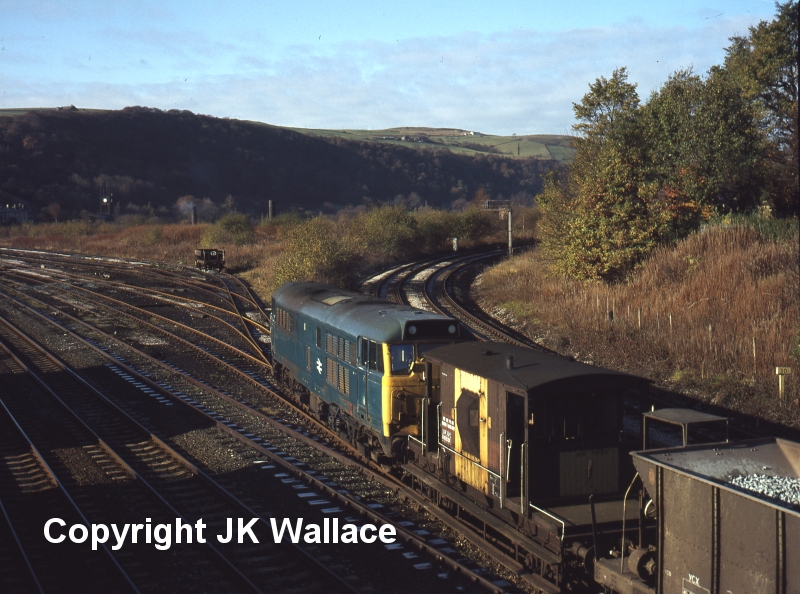
Photo G. Roose, Copyright J. K. Wallace
Brush Type 2 31290 enters the engineering sidings at Hall Royd Junction with a Permanent Way train on 12 November 1980
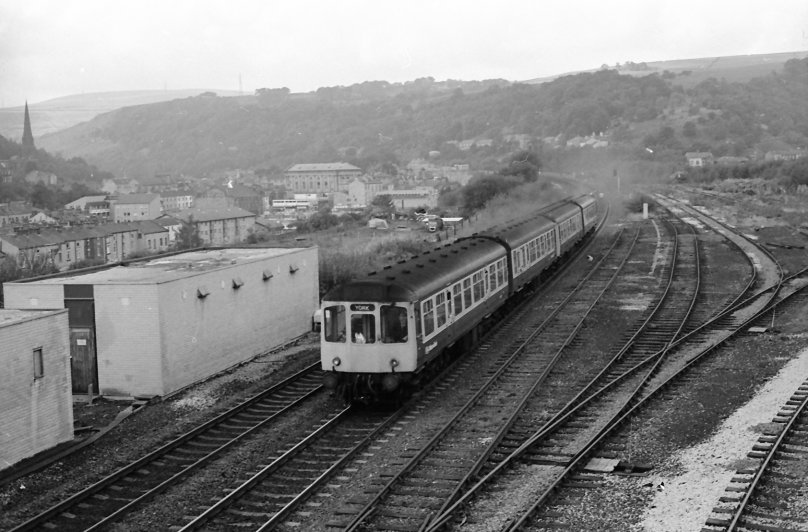
Copyright: J K Wallace, all rights reserved 2013
A Class 110 Calder Valley unit heads for York passed the Engineering Sidings at Hall Royd Junction on 1 October 1984.
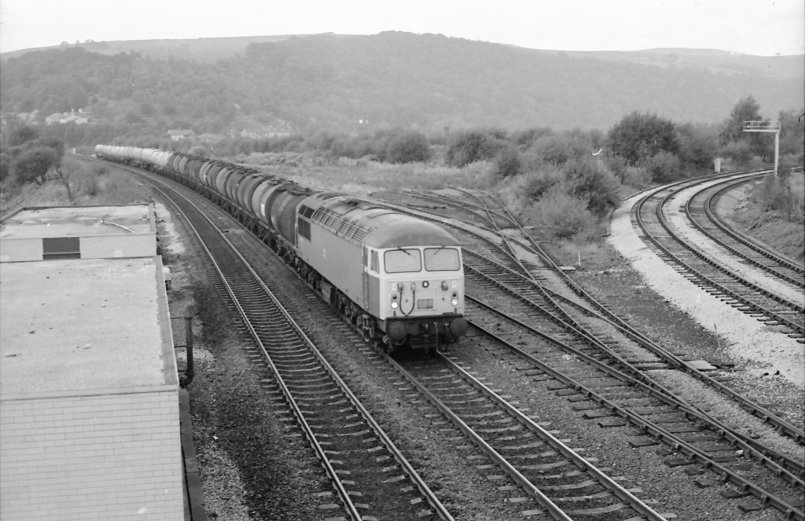
Copyright: J K Wallace, all rights reserved 2013
Class 56 56013 heads eastwards with a train of empty tanks on 1 October 1984
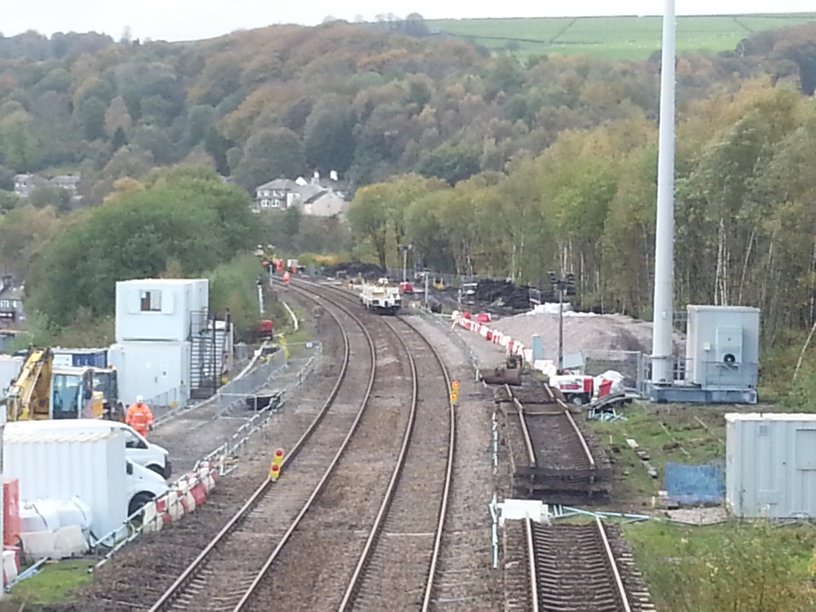
Copyright: David Greenfield November 2013
The Todmorden Curve construction office block, GSM-R mast and remains of the engineering sidings as photographed by David Greenfield in November 2013. Sadly the remains of the down loop were on borrowed time...
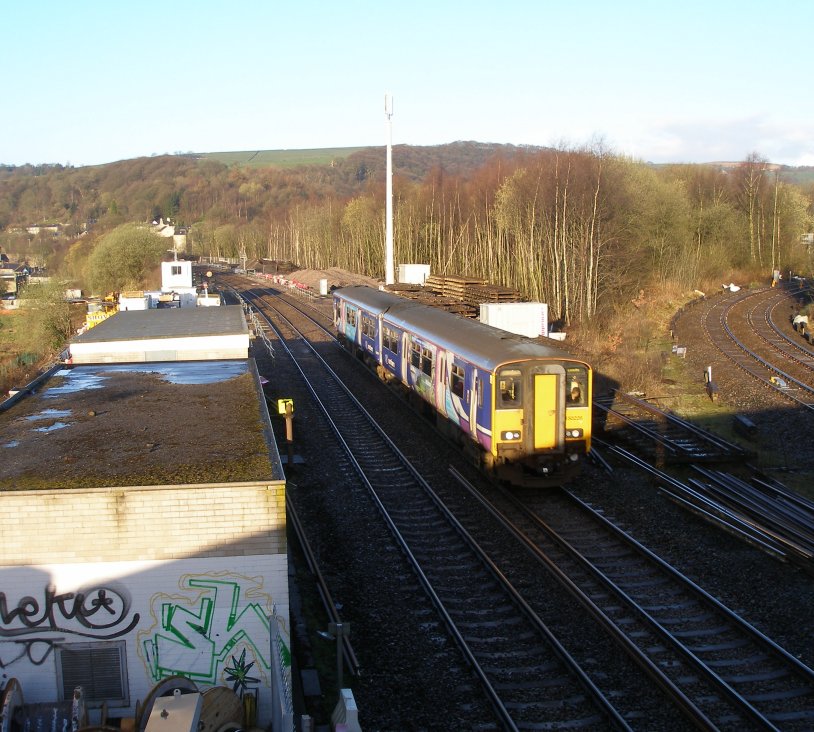
The view from Hall Royd Road bridge looking towards Todmorden on 22 March 2014. The relay room - which is the direct replacement of the old signal box - has caught the attention of the local taggers. Do you think Chris Littleworth could be persuaded to do a book of Relay Rooms on the ex-L&Y system? - start sending in your photos now... The 'Fort Todmorden' construction camp for the curve construction works can be seen in the background. However this is nothing compared to the 'motorway city' hat has been created up at Copy Pit to service the Holme Tunnel reconstruction work. The 'stop' boards can just be seen on the curve towards Stansfield Hall Junction (which, at this time, had become a junction again although still needed the signalling sorting out).

Richard Greenwood's photograph depicts BR Standard 9F 92059 wheeling a Summer Saturday's timetabled extra from Blackpool and heading for Yorkshire under Hall Royd Road bridge on 6 August 1960.
Richard Greenwood writes: "The photograph was taken on 6 August 1960 in the early afternoon. My reference is negative number ER20. The train is not a returning excursion. The headcode number is less than 500 which indicates it is a timetabled train, in fact one of the many Summer Saturday Only trains from Blackpool. The loco would have worked out during the Saturday morning in this case perhaps from Chesterfield. On that date at Hall Royd, I didn't stay long. Besides 92059 there was a K3 on a passenger from Copy; a pair of B1s and also a Crab on mainline trains, and a 2-6-4T which propelled its train (which had arrived from the East Lancs line) round the triangle. Lastly a pair of K3s including 61975 coupled light engines returning home from Blackpool."
Those were the days, and a 'thank you' to Richard for allowing use of the image here, which, of course, remains subject to Richard's copyright.
The train is made up of classic Thompson suburban stock, so some passengers will have had access to a lavatory... The locomotive is passing the exit points from the engineering sidings that paralleled the down goods and Burnley lines. Note the catch point blades incorporated in the body of the actual point. This is a common feature in the locality, there being another example at the Todmorden end of the banking loco sidings. The trap points were worked from Hall Royd Junction box, just under the bridge, as was the shunting signal on the ex-Lanky post that can be seen in the distance. The point itself was worked by the hand lever that can be seen just above the 'h'. The point connecting the sidings with the goods loop and the trap blades were conventionally worked from the signal box.
Finally, two photos from 1984 showing how the infrastructure here became progressively disused before final abandonment.This is a two-car BRCW Class 104 DMU on the Up Copy Pit line approaching Hall Royd Junction from Stansfield Hall Junction. By this time the chord between Stansfield Hall and Todmorden East, and the associated boxes, had been abandoned.
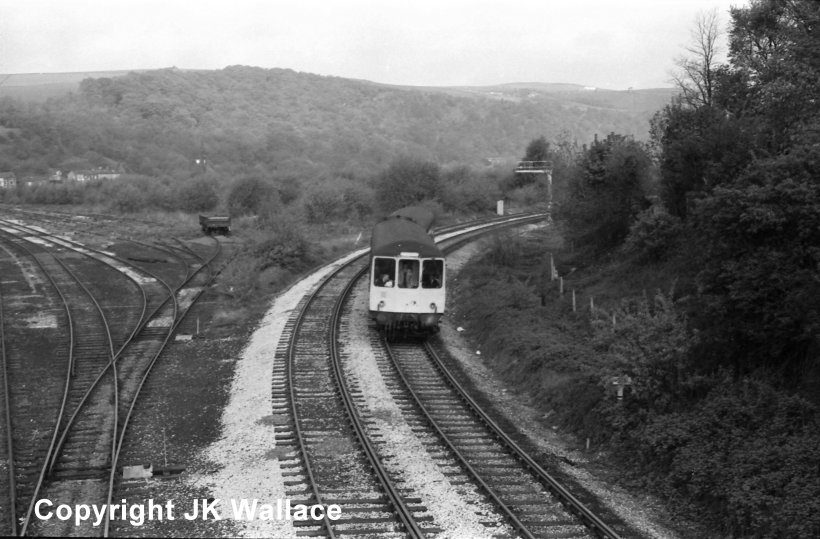
Copyright JK Wallace, all rights reserved
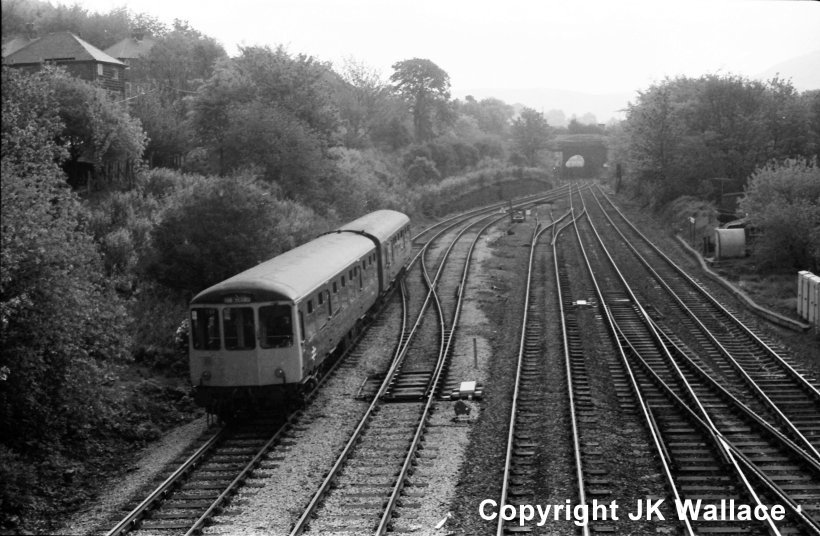
Copyright JK Wallace, all rights reserved
For views of Hall Royd as seen from Todmorden, click here.
